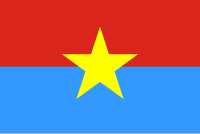
Back Viëtkong Afrikaans فيت كونغ Arabic Cənubi Vyetnam Milli Azadlıq Cəbhəsi Azerbaijani Vietcong BAR В’етконг Byelorussian Народен фронт за освобождение на Южен Виетнам Bulgarian ভিয়েত কং Bengali/Bangla Talbenn Broadel Dieubidigezh Su Viêt Nam Breton Front Nacional d'Alliberament del Vietnam Catalan Národní fronta osvobození Jižního Vietnamu Czech
| National Liberation Front of South Vietnam | |
|---|---|
| Mặt trận Dân tộc Giải phóng miền Nam Việt Nam | |
 The flag of the Viet Cong, adopted in 1960, is a variation on the flag of North Vietnam.[1] Sometimes the lower stripe was green.[2][3] | |
| Also known as | Việt Cộng (VC) the Front (Mặt trận) |
| Leaders |
|
| Dates of operation | 1954–1959 (as southern Viet Minh cadres) December 20, 1960 – February 4, 1977 |
| Merged into | |
| Allegiance | |
| Group(s) |
|
| Headquarters | |
| Active regions | Indochina, with a focus on South Vietnam |
| Ideology | |
| Political position | Far-left |
| Allies | State allies:
Non-state allies:
|
| Opponents | State opponents:
Non-state opponents: |
| Battles and wars | See full list |
The Viet Cong[nb 1] (VC) was an epithet and umbrella term to refer to the communist-driven armed movement and united front organization in South Vietnam. Formally organized as and led by the National Liberation Front of South Vietnam[nb 2] and nominally conducted military operations under the name of the Liberation Army of South Vietnam (LASV), the movement fought under the direction of North Vietnam against the South Vietnamese and United States governments during the Vietnam War. The organization had both guerrilla and regular army units, as well as a network of cadres who organized and mobilized peasants in the territory the VC controlled. During the war, communist fighters and some anti-war activists claimed that the VC was an insurgency indigenous to the South that represented the legitimate rights of people in South Vietnam, while the U.S. and South Vietnamese governments portrayed the group as a tool of North Vietnam. It was later conceded by the modern Vietnamese communist leadership that the movement was actually under the North Vietnamese political and military leadership, aiming to unify Vietnam under a single banner.
North Vietnam established the NLF on December 20, 1960, at Tân Lập village in Tây Ninh Province to foment insurgency in the South. Many of the VC's core members were volunteer "regroupees", southern Viet Minh who had resettled in the North after the Geneva Accord (1954). Hanoi gave the regroupees military training and sent them back to the South along the Ho Chi Minh trail in the late 1950s and early 1960s. The VC called for the unification of Vietnam and the overthrow of the American-backed South Vietnamese government. The VC's best-known action was the Tet Offensive, an assault on more than 100 South Vietnamese urban centers in 1968, including an attack on the U.S. embassy in Saigon. The offensive riveted the attention of the world's media for weeks, but also overextended the VC. Later communist offensives were conducted predominantly by the North Vietnamese. The organization officially merged with the Fatherland Front of Vietnam on February 4, 1977, after North and South Vietnam were officially unified under a communist government.
- ^ "National Liberation Front (Viet Cong)". www.fotw.info. Archived from the original on April 18, 2023.
- ^ Berg, Nicole M. (July 29, 2020). Discovering Kubrick's Symbolism: The Secrets of the Films. McFarland. ISBN 978-1-4766-3992-5 – via Google Books.
- ^ Gibson, Karen Bush (February 4, 2020). The Vietnam War. Mitchell Lane. ISBN 978-1-5457-4946-3 – via Google Books.
- ^ Burchett, Wilfred (1963): "Liberation Front: Formation of the NLF", The Furtive War, International Publishers, New York. (Archive)
- ^ Possibly a pseudonym for Trần Văn Trà. "Man in the News: Lt.-Gen. Tran Van Tra". February 2, 1973. Archived from the original on August 23, 2009.
- ^ Bolt, Dr. Ernest. "Provisional Revolutionary Government of South Vietnam (1969–1975)". University of Richmond. Archived from the original on October 26, 2014. Retrieved June 28, 2008.
- ^ Logevall, Fredrik (1993). "The Swedish-American Conflict over Vietnam". Diplomatic History. 17 (3): 421–445. doi:10.1111/j.1467-7709.1993.tb00589.x. JSTOR 24912244.
- ^ Cite error: The named reference
Pentagonwas invoked but never defined (see the help page).
Cite error: There are <ref group=nb> tags on this page, but the references will not show without a {{reflist|group=nb}} template (see the help page).